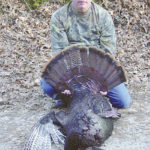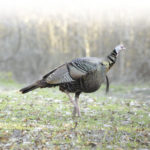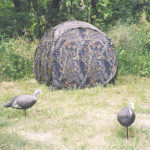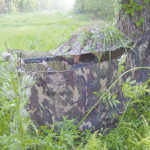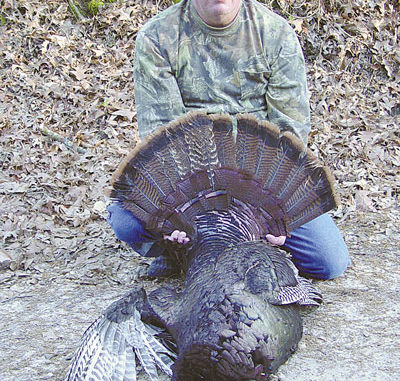
This retired biologist knows concealment is priority one when turkey hunting.
How often has the following scenario happened to you?
It is a lovely morning.
You put a bird to bed the night before and are perfectly set up for him before daylight.
Right at gobbling time the bird gobbles, just like he is supposed to.
You yelp, and he answers.
Great!
He flies down, and you get ready.
You have your shotgun aimed right at where you last heard him, but the contrary little monster steps out behind your right shoulder (he will invariably appear on the left side if you are left-handed) at 20 yards, and is staring right at you. There is no way you can get your gun on him without a fast swing or hopping up.
Anyone who has tried this understands you are not going to win many of these types of contests. Turkeys are just too fast.
As a recently retired game biologist with the Louisiana Department of Wildlife and Fisheries, part of my job was to interview turkey hunters.
I cannot tell you how many people I talked to during my 31 years of service who told me this or similar variations of the same sad tale. They got “busted,” or seen by the turkey, or got caught in a position they could not shoot from. I advised them all to get a portable blind and “bust” the turkey instead.
Blinds have enabled me to kill a large number of birds that would have gotten away had I not had one. The best example I can give was a mid-day hunt I made on one of the local management areas.
Birds on management areas have been yelped at a lot, and do not always gobble like we might prefer. They will frequently come in silent.
I set up in my little blind about noon and made a light yelp every 30 minutes or so, just to let a bird passing through the area know I was there.
I had been blinded up about an hour, but I looked all around and did not see anything, so I pulled out my call and made a couple low clucks and a very light, sweet yelp.
“Boy that sounded good,” I thought to myself.
I stuck my head up 2 inches over the top of the blind and was shocked to see a longbeard standing 5 yards away looking right at me.
“Good Lord, where did you come from?”
I slowly slunk down until I was hidden behind the blind material. I got my gun up and over. I could see the bird through the material. I had just called, and it was looking right at me!
There was no way it was going to let me stick my gun barrel over the lip of the blind, so I went ahead and shot right through the side of the blind.
It wasn’t pretty, but I got him.
Without a blind, I never would have stood a chance.
Jimmy Stafford, the wild turkey program leader, says that many turkey hunters carry a blind or blind-making materials. Probably the simplest turkey blind is made by just sticking up cut vegetation. Obviously, with the phenomenal eyesight of turkeys, this method can have problems.
Other hunters carry a length of camouflage cloth they arrange for concealment on existing vegetation. A modification of this is to have stakes sewn into the camouflage material, which is then placed around the hunter.
On the high end of portable blinds are the new array of pop-up blinds, which are constructed of camo fabric on flexible steel rods and pop into a blind with the shake of a wrist. These blinds are an excellent choice for hunters wishing to take restless children along.
Stafford points out that many blinds are too small and may limit maneuvering if the bird doesn’t cooperate. He advises hunters to use natural vegetation present to enhance whichever blind is chosen. It is much better to set up the blind amongst existing vegetation, rather than isolated out in an opening by itself.
He also suggests not setting up a blind directly in a path the turkey is expected to approach from. Get off to the side.
My first blind was homemade and constructed of cotton mosquito netting with a camouflage pattern. It was based on a simple design used by renowned Grant Parish turkey hunter John Lincecum, whom I worked with in Ferriday.
This blind was about 40 inches high, 15 feet long and held up by six aluminum rods. The blind was rolled up, and a strap held it together and served as a carrying sling. This blind set up in less than a minute. A boat cushion or other pad was carried to sit on.
I used this blind for a few years until it slowly wore out. I went down to the sporting goods store to get materials for a replacement. I was disappointed to find most of the newer camouflaged mosquito net materials were made of nylon and had a kind of sheen I was not comfortable with. In desperation, I went ahead and bought some camouflaged burlap. I cut it to a 40-inch height, but made this one 21 feet long with eight aluminum rods.
I like the blind to completely surround me and all my turkey hunting toys. If you leave a 1-inch crack, turkeys will invariably find a way to sneak up and spot you through it. This is the blind I have used ever since.
The burlap is a little more bulky and heavier, but it does not ripple in the wind like the light mosquito netting.
One big disadvantage is it will soak up water in a rain. In recent years, I have started adding one of those camouflaged half umbrellas you screw into the tree. Between the top of the blind and the bottom of the umbrella, I have a shooting slit of about 2 inches.
If I have time I will take my small folding saw and cut a bush or two to stick in front of, and on top of, the blind. Sitting back in the dark shade, I am nearly invisible.
In emergencies, the half umbrella can be set on its side and used by itself as an excellent barrier to hide behind.
You can use a turkey blind in several different ways.
If you are actively moving around a property trying to find a gobbling bird, a folded blind can be carried and set up when you get action. Of course, it should go without saying, the use of such a blind is dependent upon having the time to set it up. But you will usually have time.
Of the 44 birds I have taken, only seven did not give me time. If you hear a bird gobbling, before calling, try to get 200 yards away, and set up the blind on a likely place the bird will approach from. You may, or may not, want to set a decoy out, but do not get caught.
Another way to use a blind is in a more sedentary mode. Turkeys are often very predictable. If undisturbed, they will often follow the same route, day after day. You can set up a blind somewhere along the route where you have been seeing a turkey regularly and wait for him to come to you. Calling periodically increases the odds of attracting a bird moving through the area.
While very effective blinds can be made at the house, they can also be purchased commercially. There are a number of manufacturers (Primos, Redhead, Ameristep, etc.) out there making a variety of very good blinds. Each blind style has its limitations though.
For a general comparison of different styles, consider four different pop-up blinds manufactured by Ameristep.
The “Dog House” blind folds into a circle some 23 inches in diameter, 3 inches thick and weighs 10½ pounds. This blind is a bit bulkier and heavier than the burlap blind I usually use, but comes with a nice carrying bag complete with shoulder straps. It sets up quickly into a small tent with minimal effort. A few ground stakes hold it firm. You can then sit comfortably, or even stand up, in complete concealment, while being protected from the sun and rain.
The blinds have very nice zipper-lined windows, but be sure to keep the window in back completely closed to keep from being silhouetted.
This blind is also designed to be used by a hunter sitting in a raised chair. You will have a hard time sitting on the ground and seeing anything unless you cut a hole lower. There is plenty of room to raise a shotgun or draw a bow. This is the type of blind I would use if I were attempting to take a turkey with a bow.
A word of caution here, you do not want to let a turkey see you get out of this, or any other blind. If you let a turkey associate humans with the blind, he is going to be very leery next time he sees one.
A second model is the “Outhouse.” This blind is not as practical for turkey hunting. It folds into a 28-inch circle and weighs 9 3/4 pounds. The blind is similar to the “Doghouse,” but stands taller and is smaller in diameter. It is necessary to extend the barrel of your shotgun out the window to get in position to shoot. You will be unable to draw a compound bow in this blind. Once again, an additional chair is necessary.
Ameristep makes a smaller “2-Person Jake” model. This blind is constructed of five flexible steel hoops, which expand to form a concealment curtain, but does not have a roof. It folds quickly into a small package measuring 10 inches in diameter, and is very lightweight.
The hunter has 360-degree vision.
While advertised to conceal two people, they better be awfully small people. The blind is much more suitable for one person sitting on a cushion on the ground. This blind can be used in conjunction with a half umbrella to provide concealment and protection from the sun and rain.
A last model, referred to as a “Chair Blind,” comes in one and two-man versions, and is reputed to set up in 10 seconds. Both have chairs incorporated into the design and partial roofs, but a fairly large opening to the front increases the odds of getting spotted by a sharp-eyed turkey. Maneuverability is also very limited in the one-man version, and it is necessary to extend the shotgun well out of the blind to shoot. The two-man version is larger (60”Hx61”Wx54”D) and more practical, but heavy at 17 pounds.
Blinds definitely have a valuable place in your turkey hunting gear. Whatever type you choose, make sure it allows maneuverability, is light weight and sets up quickly.
Give one a try. I think you will be satisfied with the results. I know you will kill more birds.
